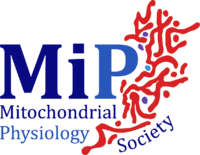Description
The Mitochondrial Physiology Socienty (MiPs) has been founded at the Third Conference on Mitochondrial Physiology (MiP2003), to organize MiP Conferences and Workshops.
Abbreviation: miPs
Reference: MiPsociety
MitoPedia topics: "Mitochondrial organization" is not in the list (Enzyme, Medium, Inhibitor, Substrate and metabolite, Uncoupler, Sample preparation, Permeabilization agent, EAGLE, MitoGlobal Organizations, MitoGlobal Centres, ...) of allowed values for the "MitoPedia topic" property. Mitochondrial organization"Mitochondrial organization" is not in the list (Enzyme, Medium, Inhibitor, Substrate and metabolite, Uncoupler, Sample preparation, Permeabilization agent, EAGLE, MitoGlobal Organizations, MitoGlobal Centres, ...) of allowed values for the "MitoPedia topic" property.
These MiPevents focus on common and cell-specific functions of mitochondria at molecular, organelle, cellular, tissue and organ levels. Thus we meet the increasing demands for integrating current developments in the methodologically and conceptually complex field of mitochondrial physiology. Mitochondrial research has undergone a dramatic renaissance, due to a whole series of discoveries revealing its central roles in cell death, disease pathology, aging, thermogenesis, oxidative stress, cell signalling, cellular regulation and cell bioenergetics. Functional genomics and proteomics is putting an urgent emphasis on integrative understanding of the link between genes/molecules and cellular/organisms functions. Because these topics require continuous technical advances there is also an emphasis on new methodological developments, quantitative methods of analysis in mitochondrial research including mathematical modeling, proteomics and the use of tools for measuring multiple parameters in an experiment. The Mitochondrial Physiology Society provides a multidisciplinary forum for high-level training courses, bringing together scientists working in divergent disciplines, to talk together about mitochondrial function and dysfunction, to resolve differences, to develop research agendas, to spread new knowledge and techniques, and to develop collaborations.Until the foundation of MiPs, mitochondrial respiratory function was mainly studied in research laboratories specializing on the bioenergetics of isolated mitochondria and bacteria, energy transformation in transmembrane gradients and characterization of the various complexes of the electron transfer system. These methods and concepts are expanded to applications on intact or permeablized cells and tissue preparations, and are widely used by groups with different research and clinical orientation, particularly in molecular cell signalling. MiPevents help to provide the expertise necessary for successful application of the techniques and concepts on mitochondrial physiology in the wider context of molecular and cell biology, exercise physiology, diagnosis of mitochondrial diseases, and evaluation of mitochondrial function in oxidative stress, ischemia-reperfusion, aging and degenerative diseases, and numerous areas of key-involvement of mitochondria.

